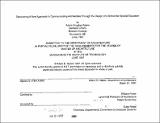Discover a new approach to communicating architecture through the design of a school for special education
Author(s)
Halem, Adam Douglas
DownloadFull printable version (5.637Mb)
Alternative title
Discovering a new approach to communicating architecture through the design of a school for special education
Advisor
William Porter.
Terms of use
Metadata
Show full item recordAbstract
Communication is a shortcoming of our profession. Go ahead and ask the ordinary person on the street to name a few famous architects. Hmmm- Frank, maybe Le Corbusier, maybe. How can we express our ideas and convey our process? How can we show our design in all its glory so that the client, the funder, the trustee, the guy that pays our bills, understand its purpose, form and function? Clearly we could just write a paper. We could include a couple of models, even a walk through on videotape. We could go to the client and show him all these things and try and convince him to hire us. Then we could hope that he will tell others involved in the funding and the building what we showed him. We could do this. We do, do this. I wanted to discover a novel approach to communicating architecture. I want you to see my approach. This thesis is my new approach to th is age old problem. I believe, as do a small number of other architects and designers, that the new approach lies in the use of today's multimedia technology. Oh a big buzz word "MULTIMEDIA". What a weird word. Multi - meaning many and Media - meaning, well just about anything, pictures, video, text, audio, 3D, 20, you name it. So multimedia means lots of anything! The word tells me everything and yet it tells me nothing. Its ambiguous. You see this is just the point. I cannot tell you. I cannot show you. You need to experience it yourself. This does not mean turning on a tape and playing it from beginning to end. It means much more; it means anything. We are finally free to do anything and everything to convey our ideas as much or as little as we want, and the whole time leaving the viewer, the client, in control. This thesis is embodied in an interactive CD-ROM which is attached to this document or available from the librarians desk. It requires an interaction with the reader. This mode of interaction results from my investigation of how communication between the lay person and the architect should occur. I argue that this affords a richer and more complete understanding of a building and its purposes than do conventional methods.
Description
Thesis (M.C.P.)--Massachusetts Institute of Technology, Dept. of Urban Studies and Planning, 1997. Includes bibliographical references (p. 30).
Date issued
1997Department
Massachusetts Institute of Technology. Department of Urban Studies and PlanningPublisher
Massachusetts Institute of Technology
Keywords
Urban Studies and Planning